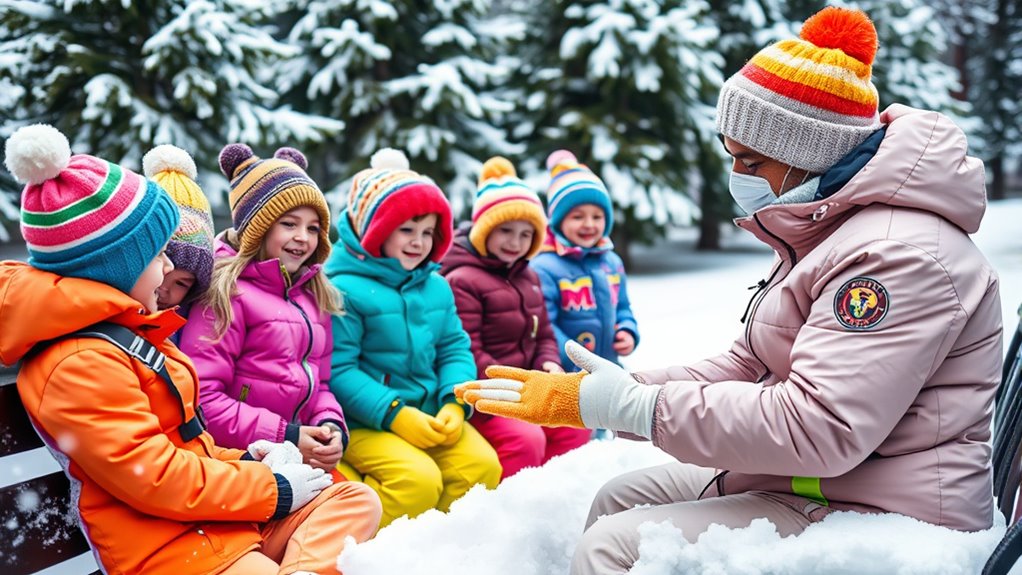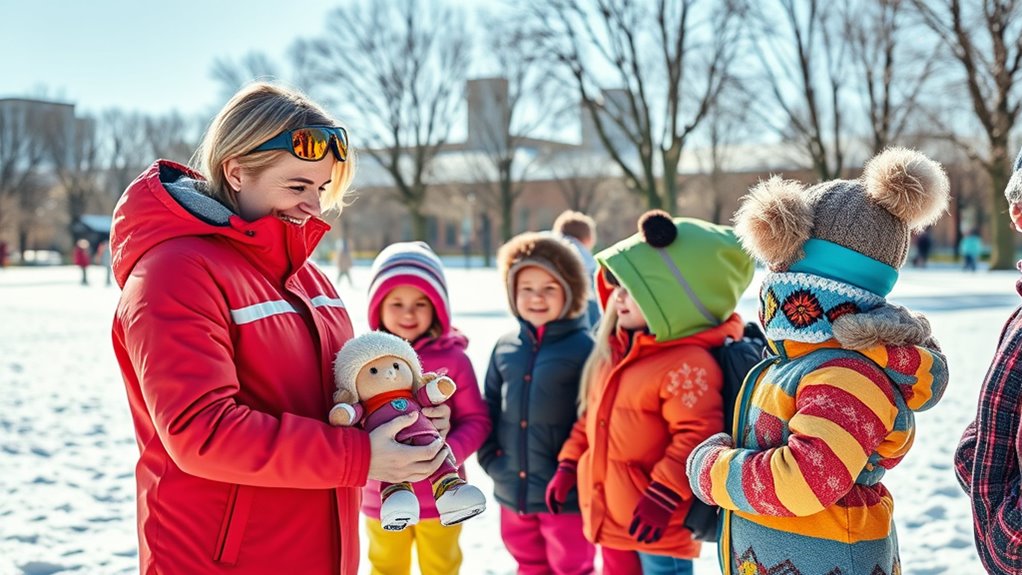To teach kids basic first aid for winter activities, focus on simple skills like cleaning small cuts with water, covering wounds, and recognizing signs of frostbite or hypothermia. Emphasize staying calm and seeking adult help for serious injuries. Show them how to stay safe around icy patches and frozen water, and explain the importance of proper clothing. If you want to learn more about keeping kids safe during winter, keep exploring practical tips and safety techniques.
Key Takeaways
- Teach children how to clean and dress minor cuts and scrapes properly.
- Show kids how to recognize signs of frostbite and hypothermia and respond quickly.
- Explain the importance of staying calm and seeking adult help during injuries or emergencies.
- Practice basic first aid techniques, like applying bandages and calling for help if needed.
- Educate children on when and how to seek medical assistance for cold-related injuries.

Winter activities can be fun and exciting, but they also come with unique risks that kids need to understand. When heading outdoors in the cold, it’s vital to prioritize snow safety to prevent injuries and ensure everyone has a good time. Teaching your kids basic first aid skills is a fundamental part of this, equipping them to handle minor accidents confidently and safely. One of the first steps is making sure they understand the importance of proper outdoor gear. Wearing the right clothing, like waterproof gloves, insulated jackets, and layered clothing, helps keep them warm and dry. Proper outdoor gear doesn’t just make winter fun more comfortable; it also reduces the likelihood of frostbite, hypothermia, and other cold-related injuries. When kids are dressed appropriately, they’re more aware of their safety and can focus on enjoying the activities rather than worrying about the cold.
You should also teach your children about the importance of recognizing dangerous situations, such as icy patches or unstable snowbanks. Snow safety involves not only knowing how to dress but also understanding how to navigate snowy terrains safely. For example, kids should be cautious around frozen ponds or lakes, ensuring the ice is thick enough before walking on it. Educate them to look for warning signs of thin ice, such as cracks or discoloration, and to avoid venturing onto frozen water without adult supervision. Additionally, instruct your kids on how to respond if someone falls through the ice—call for help immediately and keep a safe distance to avoid slipping in yourself. Incorporating lessons about robotics and automation can also enhance their understanding of how technology assists in safety and rescue efforts during winter emergencies.
In terms of first aid, teach your children basic skills like how to treat a scraped knee or a bruise after a fall. Show them how to clean minor cuts with clean water and apply a bandage. Explain the importance of keeping a wound dry and covered to prevent infection. For more serious injuries, like broken bones or head injuries, emphasize the importance of staying calm and seeking adult help right away. Also, teach them how to recognize signs of frostbite or hypothermia, such as numbness, pale skin, shivering, or confusion, and the importance of getting warm and seeking medical help immediately.
Frequently Asked Questions
How Can Kids Recognize Frostbite Early?
You can help kids recognize frostbite early by teaching them to look for frostbite symptoms like numbness, pale or waxy skin, and cold, hard areas. Encourage them to check exposed skin often during winter activities. If they notice any signs, they should get indoors quickly and warm the affected area gently. Early detection is key to preventing more serious damage, so make sure they know to alert an adult immediately.
What Should Kids Do if They Get Hypothermia?
Ever wonder what to do if someone shows signs of hypothermia? You should immediately remove them from cold exposure, gently warm their body using blankets or clothing, and avoid direct heat. Keep emergency communication open by calling for help if symptoms are severe. Remember, acting quickly can prevent serious complications, so stay calm, keep them warm, and monitor their condition until professional help arrives.
How Do I Explain First Aid to Young Children?
To explain first aid to young children, use child-friendly language that they can easily understand. Keep it simple and engaging by using stories or fun examples. Show them through demonstrations, like how to check for injuries or call for help, making it interactive. This way, kids stay interested, learn quickly, and remember what to do if someone gets hurt during winter activities.
Are There Winter-Specific First Aid Kits for Kids?
Yes, there are winter-specific first aid kits designed for kids. These kits often include items like insulated gloves, hand warmers, and supplies for treating frostbite or hypothermia. Keep your child’s winter gear in mind when choosing a first aid kit, ensuring it contains essentials for cold-weather injuries. Having a specialized kit ready helps you respond quickly and keeps your child safe during winter adventures.
How Can I Ensure Kids Stay Warm During First Aid Training?
Think of keeping kids warm during first aid training as wrapping a delicate gift with multiple layers of protection. Use layering techniques, such as thermal underwear, fleece, and waterproof outerwear, to trap heat effectively. Choose outdoor gear like insulated gloves, hats, and boots that shield against cold. This layered approach guarantees kids stay warm, comfortable, and ready to learn, even in the chilliest winter conditions.
Conclusion
By teaching kids basic first aid for winter activities, you’re giving them the confidence to handle emergencies and enjoy the season safely. Imagine how proud they’ll feel knowing they can help themselves or others in tricky situations. Isn’t it worth investing a little time now to guarantee they’re prepared? With these skills, they can make winter adventures safer and more fun for everyone. So, are you ready to start teaching your kids these essential safety tips today?









